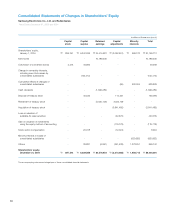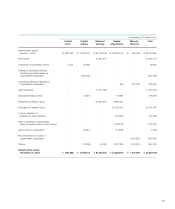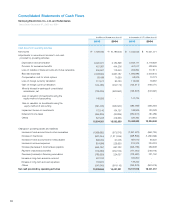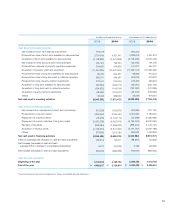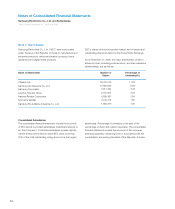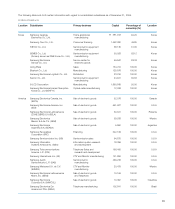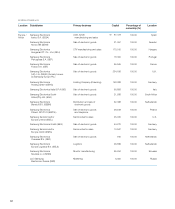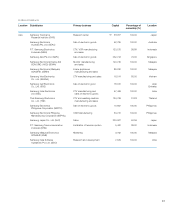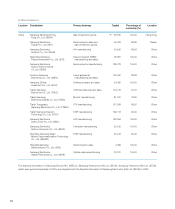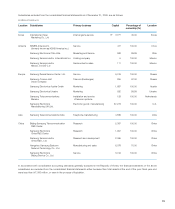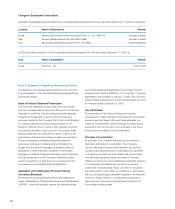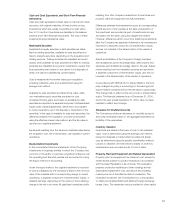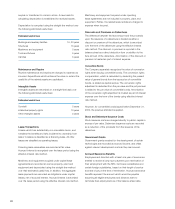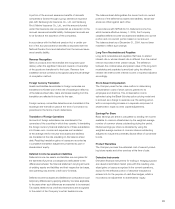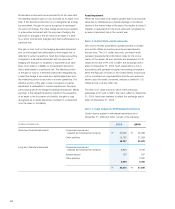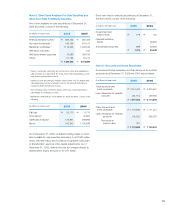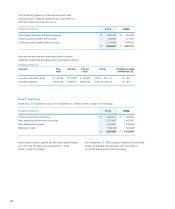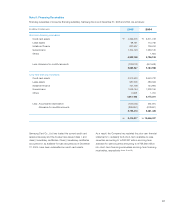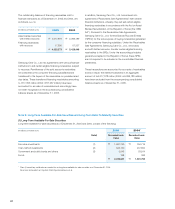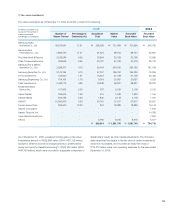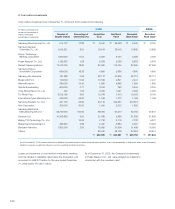Samsung 2005 Annual Report Download - page 92
Download and view the complete annual report
Please find page 92 of the 2005 Samsung annual report below. You can navigate through the pages in the report by either clicking on the pages listed below, or by using the keyword search tool below to find specific information within the annual report.
90
Changes in Subsidiaries Consolidated
(a) Details of subsidiaries newly included in the consolidated financial statements for the year ended December 31, 2005, are as follows:
Location Name of Subsidiaries Remark
Korea Samsung Electronics Hainan Fiberoptics Korea. Co., Ltd. (SEHF-K) Increase in assets
Asia Samsung Malaysia Electronics SDN BHD (SME) Increase in assets
Asia Samsung India Software Operations Pvt. Ltd. (SISO) Newly established
(b) The subsidiary excluded from the consolidated financial statements for the year ended December 31, 2005, is:
Area Name of subsidiaries Remark
Korea Novita Co., Ltd. Sold in 2005
Note 2: Summary of Significant Accounting Policies
The significant accounting policies followed by the Company
in the preparation of its consolidated financial statements are
summarized below:
Basis of Financial Statement Presentation
The Company maintains its accounting records in Korean
won and prepares statutory financial statements in the Korean
language in conformity with accounting principles generally
accepted in the Republic of Korea. Certain accounting
principles applied by the Company that conform with financial
accounting standards and accounting principles in the
Republic of Korea may not conform with generally accepted
accounting principles in other countries. Accordingly, these
financial statements are intended for use by those who are
informed about Korean accounting principles and practices.
The accompanying consolidated financial statements
have been condensed, restructured and translated into
English from the Korean language consolidated financial
statements. Certain information attached to the Korean
language consolidated financial statements, but not required
for a fair presentation of the Company’s financial position,
results of operations or cash flows, is not presented in the
accompanying consolidated financial statements.
Application of the Statements of Korean Financial
Accounting Standards
The Korean Accounting Standards Board has published a
series of Statements of Korean Financial Accounting Standards
(“SKFAS”), which will gradually replace the existing financial
accounting standards established by the Korean Financial
and Supervisory Board. SKFAS No.15 through No.17 became
applicable to the company in January 1, 2005. The Company
adopted these statements in its financial statements as of and
for the year ended December 31, 2005.
Use of Estimates
The preparation of the financial statements requires
management to make estimates and assumptions that affect
amounts reported therein. Although these estimates are
based on management’s best knowledge of current events
and actions that the Company may undertake in the future,
actual results may differ from those estimates.
Principles of Consolidation
All significant inter-company transactions and balances
have been eliminated in consolidation. The Company
records differences between the investment account and
corresponding capital account of subsidiaries as a goodwill
or a negative goodwill, and such differences are amortized
over five years using the straight-line method. However,
differences which occur from additional investments acquired
in consolidated subsidiaries are reported in a separate
component of shareholders’ equity, and are not included in
the determination of the results of operations. In accordance
with accounting principles generally accepted in the Republic
of Korea, minority interest in consolidated subsidiaries is
presented as a component of shareholders’ equity in the
consolidated balance sheet.


